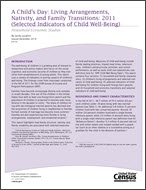A Child's Day: Living Arrangements, Nativity, and Family Transitions: 2011 (Selected Indicators of Child Well-Being)
A Child's Day: Living Arrangements, Nativity, and Family Transitions: 2011 (Selected Indicators of Child Well-Being)
Introduction
The well-being of children is a growing area of interest to researchers and policy makers who focus on the social, cognitive, and economic security of children as they transition from preadolescents to young adults. This report uses a variety of indicators to portray aspects of children’s well-being. The findings come from interviews conducted in the fall of 2011 for the 2008 Survey of Income and Program Participation (SIPP).
Families have become increasingly diverse and complex in recent decades. One out of five children in the United States lives with at least one foreign-born parent and the population of children is projected to become even more diverse in the decades to come.1 The share of children living with two biological married parents has declined and the proportion of children living in stepfamilies or families formed outside of marriage has become more common.2 Families are also experiencing more fluidity in living arrangements, employment, and residential location.3
This report highlights how family structure, nativity, and family instability are associated with selected measures of child well-being. Measures of child well-being include family reading practices, shared meal times, television rules, children’s extracurricular activities, and school performance, as well as early child care experiences (see definition box for “SIPP Child Well-Being Data”). The report contains four sections: (1) household and family characteristics, (2) children’s living arrangements and selected indicators of child well-being, (3) selected indicators of child well-being for children living with foreign-born parents, and (4) household and economic transitions and selected indicators of child well-being.
_______________
1 Federal Interagency Forum on Child and Family Statistics. America’s Children: Key National Indicators of Well-Being, 2013, Washington, DC: U.S. Government Printing Office.
2 Rose M. Kreider and Renee Ellis, “Living Arrangements of Children: 2009,” Household Economic Studies, P70-126, U.S. Census Bureau, Washington, DC, 2011.
3 Andrew J. Cherlin, “Demographic Trends in the United States: A Review of Research in the 2000s,” Journal of Marriage and Family, 72, 2010 403–419.
Others in Series
Publication
Publication
Publication




